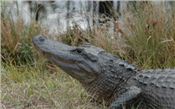How To Safely Avoid Encountering Arkansas’ Alligators

Becky McPeake, extension wildlife specialist for the University of Arkansas System Division of Agriculture, said that like many wild animals, American alligators found in southern and central Arkansas are wary of humans and will avoid them if given the opportunity.
REBEKAH HALL
LITTLE ROCK, ARKANSAS
While enjoying the Natural State’s many bodies of water this summer, swimmers and boaters need to avoid hazardous wildlife. This includes American alligators, which are present in southern and central Arkansas. Becky McPeake, extension wildlife specialist for the University of Arkansas System Division of Agriculture, said understanding alligators is key to avoiding negative encounters.
McPeake said dense populations of American alligators (Alligator mississippiensis) have been reported at Arkansas Post National Memorial in Arkansas County and Millwood State Park in Little River County. In June, a kayaker videoed a large alligator on Lake Conway in central Arkansas.
Though this species was considered endangered 60 years ago, McPeake said their populations have recovered throughout most of their native range, including southern Arkansas. The state is considered the northwestern edge of the alligator’s range in the United States, and most of northern Arkansas is “too cool temperature-wise for these reptiles to survive,” McPeake said.
Alligators are “opportunistic predators” that consume a variety of animals during their different life stages and sizes. Young alligators eat crayfish, insect larvae, snails, spiders, worms, small fish, snakes and lizards. Older alligators typically prey on larger creatures, including nutria – a type of large, semiaquatic rodent – beaver, muskrats, raccoons, opossums, water birds, feral hogs and white-tailed deer. When able to access domestic spaces, alligators are also known to prey on domestic dogs, cats and calves.
“Typically, an alligator will not chase you down and eat you when seen in a natural state,” McPeake said. “Scary movies and social media entertain audiences by showing aggressive alligators. Like many wild animals, they are wary and avoid people when given the opportunity.”
While fatal attacks on humans are rare, they do occur, primarily in the southeastern United States. McPeake said being safe around alligators is straightforward: never feed them and move away when they are seen.
“Be mindful of their presence and avoid them,” McPeake said. “Do not provoke, throw objects, or try to move an alligator. Keep away from shorelines, especially pets and children, where alligators are present.”
McPeake said most alligator encounters occur in a few different scenarios: when the reptiles are basking beside water; when a female alligator is protecting her nest or babies; when an alligator is crossing a road; and when they have been fed or become familiar with being around people.
It’s important to be cautious when swimming, canoeing or fishing in waterways with alligators. Keep at least 60 feet away.
“If an alligator hisses or lunges at you, you are too close,” McPeake said. “Do not corner alligators. Always provide them with an escape route.”
If an alligator is a threat to humans, pets or livestock, call the Arkansas Game and Fish Commission at 800-364-4263. ∆
REBEKAH HALL: University of Arkansas